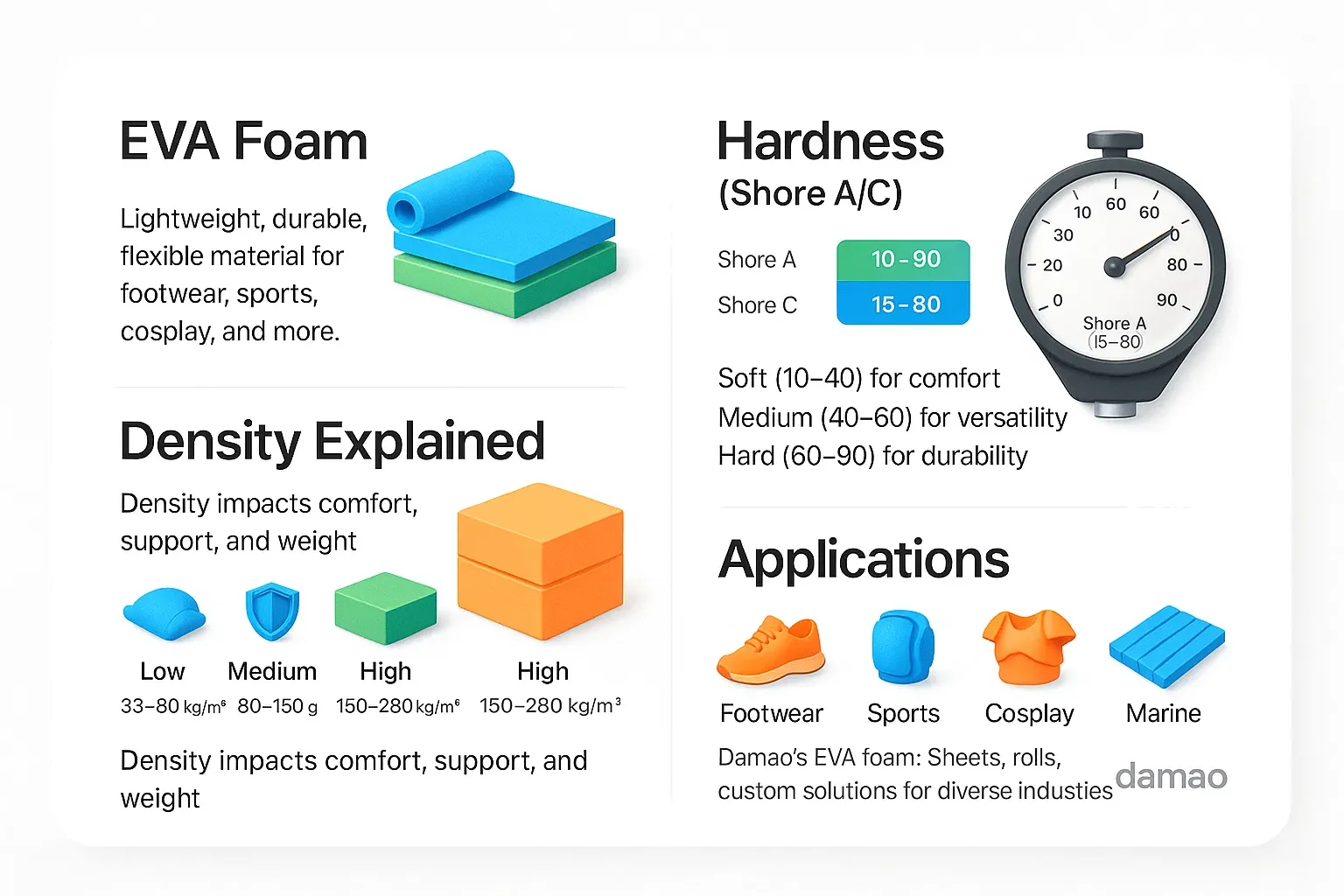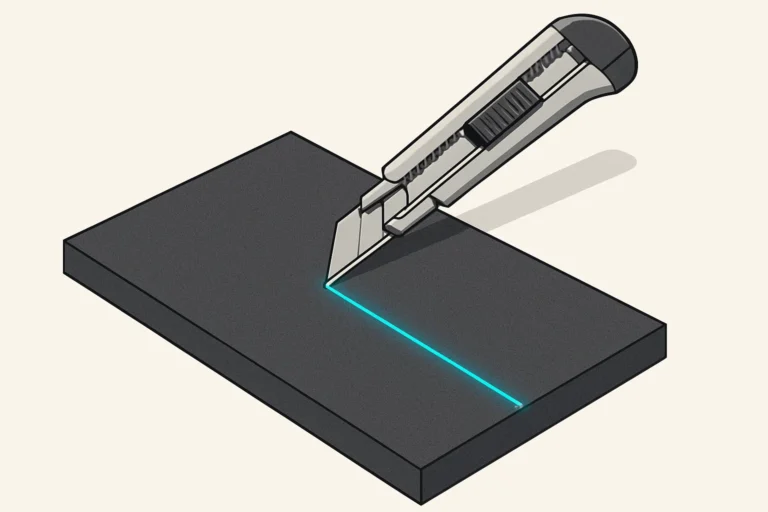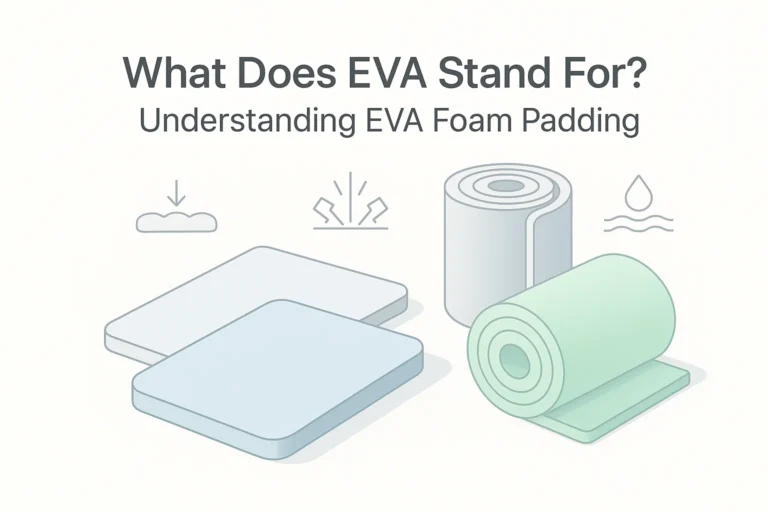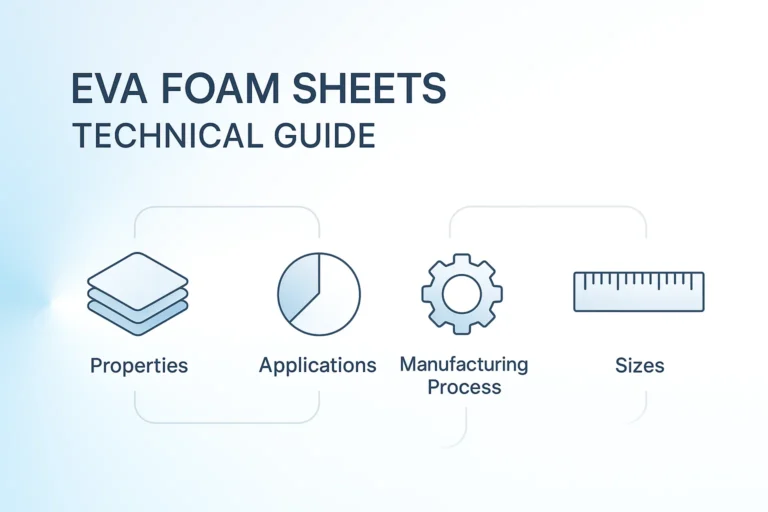Inzicht in de dichtheid en hardheid van EVA-schuim: Shore A/C uitgelegd
Welkom in de wereld van EVA-schuim, een veelzijdig materiaal dat furore maakt in verschillende sectoren, van schoenen en sportartikelen tot cosplay en industriële toepassingen. Bij Damao zijn we gespecialiseerd in platen, rollen, op maat gemaakte producten en oplossingen voor specifieke toepassingen van EVA-schuim. Of u nu fabrikant, ontwerper of hobbyist bent, inzicht in de dichtheid en hardheid van EVA-schuim – gemeten op de Shore A- en Shore C-schaal – is essentieel voor het kiezen van het juiste materiaal voor uw project. In dit artikel leggen we deze concepten op een toegankelijke manier uit, zodat u weloverwogen beslissingen kunt nemen om de prestaties voor uw behoeften te optimaliseren.
Wat is EVA-schuim?
EVA-schuim (ethyleenvinylacetaat) is een lichtgewicht en duurzaam schuim met gesloten cellen dat bekendstaat om zijn flexibiliteit, schokabsorptie en water-, uv- en scheurbestendigheid. Het is gemaakt van een mix van ethyleen, vinylacetaat en schuimadditieven, wat resulteert in een materiaal dat zowel elastisch als semi-stijf is. Bij Damao bieden we EVA-schuim aan in verschillende vormen – platen, rollen en op maat gemaakte producten – ontworpen voor sectoren zoals de schoenen-, watersport-, sport-, verpakkings- en cosplaysector.
Maar wat onderscheidt het ene EVA-schuimproduct van het andere? Het antwoord ligt in twee cruciale eigenschappen: dikte En hardheidDeze factoren bepalen hoe het schuim presteert in specifieke toepassingen, van demping in schoenzolen tot impactbestendigheid in beschermende kleding. Laten we deze eigenschappen eens nader bekijken en bekijken hoe ze de prestaties beïnvloeden.
EVA-schuimdichtheid: de basis van prestaties
Wat is de dichtheid van EVA-schuim?
Dichtheid verwijst naar de massa van EVA-schuim per volume-eenheid, doorgaans gemeten in kilogram per kubieke meter (kg/m³). De dichtheid varieert van lage dichtheid (ongeveer 33 kg/m³) tot ultrahoge dichtheid (tot 280 kg/m³), afhankelijk van het productieproces en het beoogde gebruik. Dichtheid beïnvloedt het gewicht, de sterkte en de samendrukbaarheid van het schuim.
- EVA-schuim met lage dichtheid (33–80 kg/m³): Lichtgewicht en zacht, ideaal voor dempende toepassingen zoals helmvulling of yogamatten.
- EVA-schuim met gemiddelde dichtheid (80–150 kg/m³): Een balans tussen flexibiliteit en duurzaamheid, gebruikt in schoenzolen en sportuitrusting.
- EVA-schuim met hoge dichtheid (150–280 kg/m³): Sterker en stijver, perfect voor schoenplatforms, vloeren of cosplay-pantsering.
Bij Damao zijn onze EVA-schuimproducten verkrijgbaar in alle dichtheidsvarianten, zodat u het juiste materiaal voor uw specifieke toepassing kunt kiezen.
Hoe dichtheid de prestaties beïnvloedt
Dichtheid speelt een cruciale rol bij het bepalen hoe EVA-schuim zich onder druk gedraagt. Zo werkt het:
- Demping en comfort: Schuim met een lage dichtheid is zachter en beter samendrukbaar, waardoor ze uitstekend geschikt zijn voor toepassingen die comfort vereisen, zoals inlegzolen of kniebeschermers. Ze absorberen schokken effectief, maar kunnen sneller slijten bij intensief gebruik.
- Duurzaamheid en ondersteuning: Schuim met hoge dichtheid is stijver en beter bestand tegen druk, wat zorgt voor een betere structurele stabiliteit bij toepassingen zoals orthopedische ondersteuning of scheepsdekken. Ze zijn bestand tegen herhaaldelijke schokken en behouden hun vorm in de loop van de tijd.
- Gewicht:Schuimen met een hogere dichtheid zijn zwaarder, wat een overweging kan zijn voor toepassingen zoals cosplay, waar lichtgewicht materialen de voorkeur hebben vanwege het gebruiksgemak.
Zo zijn de EVA-schuimplaten met hoge dichtheid van Damao een uitstekende keuze voor schoenfabrikanten die duurzame tussenzolen vervaardigen, terwijl onze rollen met lage dichtheid populair zijn voor het creëren van zachte, comfortabele vulling in sportuitrustingen.
EVA-schuimhardheid: meten met Shore A en Shore C
Shore-hardheidsschalen begrijpen
Hardheid meet de weerstand van een materiaal tegen indrukking of penetratie. Voor EVA-schuim wordt dit meestal gemeten met de Shore A- of Shore C-schaal. Deze schalen gebruiken een durometer om te meten hoe hard of zacht een materiaal is, waarbij hogere waarden een hogere hardheid aangeven.
- Shore A-schaal: Shore A wordt gebruikt voor hardere rubbersoorten en semi-rigide kunststoffen en is gebruikelijk voor EVA-schuim met een gemiddelde tot hoge dichtheid. De dichtheid varieert van 10A (extreem zacht, zoals een elastiekje) tot 90A (hard en duurzaam, bestand tegen hoge druk).
- Shore C-schaalShore C wordt vaak gebruikt voor zachtere, flexibelere schuimsoorten en is gebruikelijk voor EVA-schuim met een lage tot gemiddelde dichtheid. Het overlapt met Shore A, maar is beter geschikt voor het meten van de samendrukbaarheid in zachtere materialen. Zo is een schuim met 25 Shore C zachter dan een met 70 Shore C.
Bij Damao leveren we EVA-schuim met hardheden van 15 tot 80 Shore C en 10 tot 90 Shore A. Zo hebben we voor elke toepassing de juiste opties, van zachte vulling tot stijve ondersteuningen.
Hoe hardheid de prestaties beïnvloedt
Hardheid heeft een directe invloed op hoe EVA-schuim aanvoelt en presteert in de praktijk. Hieronder een overzicht:
- Zachte schuimen (10–40 Shore A/C): Deze zijn zeer samendrukbaar en flexibel, ideaal voor toepassingen die maximaal comfort vereisen, zoals inlegzolen voor diabetici of helmvulling. Ze bieden uitstekende schokabsorptie, maar zijn mogelijk minder duurzaam bij zware belasting. Damao's schuim met lage dichtheid en lage hardheid is perfect voor dit soort toepassingen.
- Middelgrote schuimen (40–60 Shore A/C): Deze schuimen bieden een balans tussen flexibiliteit en sterkte en zijn veelzijdig inzetbaar voor toepassingen zoals schoenzolen, sportuitrusting en cosplay-rekwisieten. Ze bieden een goede schokbestendigheid en zijn toch vormbaar en licht. De platen en rollen met gemiddelde dichtheid van Damao zijn populair voor deze doeleinden.
- Hardschuim (60–90 Shore A/C): Deze schuimen zijn stijf en duurzaam en geschikt voor toepassingen met hoge impact, zoals vloeren, platformen voor schoenen of steunzolen. Ze zijn bestand tegen compressie en behouden hun vorm onder druk, waardoor ze ideaal zijn voor Damao's op maat gemaakte producten voor industrieel gebruik.
Shore A versus Shore C: welke moet je gebruiken?
De keuze tussen Shore A en Shore C hangt af van de dichtheid van het schuim en de beoogde toepassing. Voor zachtere schuimsoorten met een lage dichtheid (bijvoorbeeld voor demping) biedt Shore C een nauwkeurigere meting. Voor hardere schuimsoorten met een hoge dichtheid (bijvoorbeeld voor structurele componenten) heeft Shore A de voorkeur. Bij Damao labelen we onze producten duidelijk met hun Shore-hardheidsclassificatie om u te helpen het juiste schuim voor uw behoeften te kiezen.
Hoe dichtheid en hardheid samenwerken
Dichtheid en hardheid zijn nauw met elkaar verbonden, maar ze zijn niet hetzelfde. Schuim met hoge dichtheid is vaak harder, maar de specifieke hardheid hangt af van factoren zoals de EVA-polymeermix, additieven en de dichtheid van de crosslinking tijdens de productie. Hier is hoe ze op elkaar inwerken:
- Schuim met lage dichtheid en lage hardheid: Deze zijn zacht en lichtgewicht, ideaal voor comfortgerichte toepassingen zoals vulling of inlegzolen. Ze comprimeren gemakkelijk, maar zijn mogelijk niet bestand tegen zware slijtage.
- Schuimen met hoge dichtheid en hoge hardheid: Deze zijn stijf en duurzaam, perfect voor structurele toepassingen zoals ortheses of cosplay-pantsers. Ze zijn bestand tegen compressie en behouden hun vorm onder druk.
- Gemengde combinaties:Een schuim met een gemiddelde dichtheid en een hoge hardheid kan een unieke balans bieden, zoals bij sportuitrustingen waarbij zowel flexibiliteit als duurzaamheid nodig zijn.
Bij Damao werken we nauw samen met klanten om EVA-schuimproducten op maat te maken die de gewenste dichtheid en hardheid hebben voor hun specifieke toepassingen. Zo garanderen we optimale prestaties.
Impact op prestaties in specifieke toepassingen
Laten we eens kijken hoe de dichtheid en hardheid van EVA-schuim de prestaties beïnvloeden in enkele van de belangrijkste toepassingsgebieden van Damao:
Schoenen (Inlegzolen, Tussenzolen, Plateaus)
- Zacht schuim met lage dichtheid (20–35 Shore C): Deze worden gebruikt als inlegzolen en bieden demping en comfort, waardoor voetvermoeidheid wordt verminderd. Ze zijn ideaal voor diabetisch of therapeutisch schoeisel, zoals te zien is in Damao's SoftCell-geïnspireerde producten.
- Hoge dichtheid, harde schuimen (60-75 Shore C): Deze worden gebruikt voor tussenzolen en plateaus en bieden structurele ondersteuning en duurzaamheid, waardoor schoenen bestand zijn tegen herhaaldelijke schokken. De platen met hoge dichtheid van Damao zijn favoriet bij schoenfabrikanten.
Sportuitrusting (vulling, helmen, kniebeschermers)
- Schuim met gemiddelde dichtheid en gemiddelde hardheid (40–60 Shore A/C): Deze bieden een balans tussen schokabsorptie en duurzaamheid, waardoor ze ideaal zijn voor beschermende uitrusting zoals kniebeschermers of helmvulling. De rollen van Damao worden veel gebruikt in sporttoepassingen vanwege hun veelzijdigheid.
- Hoge dichtheid, harde schuimen (60-90 Shore A):Deze schuimsoorten worden gebruikt in sportuitrustingen met een hoge impact, zijn bestand tegen compressie en behouden hun vorm, waardoor ze langdurige bescherming bieden.
Cosplay en knutselen
- Schuim met gemiddelde dichtheid en gemiddelde hardheid (40–50 Shore C): Deze schuimen zijn populair voor cosplay-harnassen en -rekwisieten. Ze zijn lichtgewicht, vormbaar met hitte en gemakkelijk te knippen of te lijmen. Damao's EVA-schuimplaten zijn een must-have voor cosplayers die ingewikkelde ontwerpen maken.
- Hoge dichtheid, harde schuimen (60-75 Shore C):Deze schuimsoorten worden gebruikt voor stijve componenten zoals wapensteunen en bieden structurele integriteit, terwijl ze toch bewerkbaar zijn met gereedschappen zoals Dremels of heteluchtpistolen.
Marine- en buitentoepassingen
- Schuim met lage tot gemiddelde dichtheid (33–100 kg/m³, 20–40 Shore C): Deze zijn drijvend en waterbestendig, waardoor ze ideaal zijn voor scheepsdekken, kickboards en drijvende apparaten. De rollen met lage dichtheid van Damao blinken uit in deze toepassingen.
- Schuim met hoge dichtheid (150–280 kg/m³, 60–80 Shore A): Deze schuimsoorten zijn geschikt voor duurzame maritieme terrassen of zitplekken buiten. Ze zijn bestand tegen zware weersomstandigheden en intensief gebruik.
Industrieel en verpakking
- Hoge dichtheid, harde schuimen (60-90 Shore A): Deze worden gebruikt voor geluidsisolatie, vloeren of verpakkingen en bieden duurzaamheid en slagvastheid. De op maat gemaakte producten van Damao zijn afgestemd op industriële behoeften.
- Schuim met gemiddelde dichtheid (40–60 Shore C):Deze schuimsoorten worden gebruikt als demping bij verpakkingen en beschermen kwetsbare artikelen tijdens het transport.
Het kiezen van het juiste EVA-schuim voor uw project
Het kiezen van het perfecte EVA-schuim vereist dat de dichtheid en hardheid overeenkomen met de eisen van uw project. Hier zijn enkele tips om u te helpen:
- Definieer uw toepassing: Maak je zachte vulling, stijve steunen of lichtgewicht props? Door te weten wat je uiteindelijk wilt gebruiken, kun je de opties beperken.
- Houd rekening met omgevingsfactoren: Voor buiten- of maritieme toepassingen zijn waterbestendigheid en UV-bestendigheid belangrijke factoren, zoals te vinden is in de gesloten cel EVA-schuimen van Damao.
- Test voor comfort versus duurzaamheid:Zachte schuimsoorten met een lage dichtheid bieden veel comfort, terwijl harde schuimsoorten met een hoge dichtheid uitstekend geschikt zijn voor structurele toepassingen.
- Raadpleeg expertsBij Damao helpt ons team u graag bij het aanpassen van EVA-schuimplaten, -rollen of afgewerkte producten aan uw exacte specificaties.
Waarom kiezen voor Damao voor EVA-schuim?
Bij Damao streven we ernaar hoogwaardig EVA-schuim te leveren, afgestemd op uw behoeften. Onze producten zijn:
- Aanpasbaar: Verkrijgbaar in platen, rollen en op maat gemaakte vormen, met een dichtheid variërend van 33 tot 280 kg/m³ en een hardheid van 15 tot 80 Shore C of 10 tot 90 Shore A.
- DuurzaamOnze productiepartners voldoen aan de certificeringen Recycled Claim Standard (RCS) en Global Recycled Standard (GRS). Daarmee garanderen we een milieubewuste productie met minimaal 20% gerecycled materiaal.
- Veelzijdig: Ontworpen voor sectoren als schoenen, sport, scheepvaart, cosplay en verpakking, met opties voor warmtevormen, lijmen en afwerking.
- Betrouwbaar:Ondersteund door strenge kwaliteitscontrole en een focus op duurzaamheid, comfort en prestaties.
Of u nu EVA-schuim nodig heeft voor een specifieke toepassing of een aangepast project, Damao beschikt over de expertise en producten om uw visie tot leven te brengen.
Conclusie
Inzicht in de dichtheid en hardheid van EVA-schuim (Shore A/C) is de sleutel tot het volledig benutten van het potentieel ervan voor uw projecten. Door de juiste combinatie van dichtheid en hardheid te kiezen, kunt u optimale prestaties garanderen, of u nu comfortabele inlegzolen, duurzame scheepsdekken of complexe cosplay-pantsers maakt. Bij Damao staan we klaar om u bij elke stap te begeleiden en bieden we hoogwaardige EVA-schuimplaten, rollen en maatwerkoplossingen, afgestemd op uw behoeften.
Klaar om de mogelijkheden van EVA-schuim te verkennen? Neem vandaag nog contact op met Damao om uw projectvereisten te bespreken of bekijk ons productassortiment op onze websiteLaten we samen iets geweldigs creëren!
Benut het potentieel van EVA-schuim met Damao's gids over dichtheid en hardheid (Shore A/C). Ontdek hoe deze eigenschappen de prestaties beïnvloeden in toepassingen zoals schoenen, sportuitrusting en cosplay, en kies het perfecte schuim voor jouw project.







